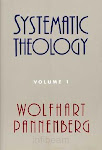This is an essay on the nature of doctrine. References are to Jaroslav Pelikan’s monographs on the development of Christian doctrine. Reference (3:241) would refer to volume 3, page 241.
1. Doctrine is “important”
2. Doctrine and mystery
3. The inadequacy of doctrine
4. The inevitability of doctrine
5. The scope of doctrine
6. “Hierarchies” of doctrine
7. The relation of words and reality
8. Liturgy as the fulfillment of doctrine
9. Love as the fulfillment of doctrine
-- -- --
Liturgy as the Fulfillment of Doctrine
There may be satisfactory answers to the questions in this essay, most of which have been left open. Some answers may even be expressible in words (the topic of the previous post)!
Whatever the case, it must be admitted that even the best answers and formulations do not suffice. This is consoling, for I am lacking the best answers and formulations.
For, as it is, undoubtedly some “nuances”, say, of christology are unintelligible to us “simple” people. But fortunately what is said of icons applies to liturgy in general: they are “books for the illiterate” (2:132). When words fail us, liturgy and love in action take over and fulfill what mere words, by themselves, were never meant to fulfill.
Throughout Pelikan’s monographs liturgy has been a main source (see e.g. 2:6); and throughout my essays I have mainly ignored it, as well as the “powerful monastic movement” (2:5-6) and several other important and intriguing elements in the history of the development of Christian doctrine. But now liturgy comes into play.
Earlier it was said that the central obligation of the church is the “communication of what has been granted” it (2:31). Liturgy (worship) is uniquely “the summit toward which the activity of the church is directed and at the same time the fountain from which all her power flows”, as was stated at the Second Vatican Council (5:295).
Maximus’s reminder of the words of Scripture can be considered valid to theological words, too: “every word … is a forerunner of the more perfect word to be revealed … in an unwritten way in the Spirit” (2:31). “The heart” of all major churches, not only of the Syrian Jacobite Church to which this Hage’s expression originally refers to, “beats in its liturgy” (2:51). And Nicephorus’s formulation of the liturgical action of “their priests” can be generalized to encompass all liturgical action and participation: “they express the form of the orders of being that transcend this world” (2:134).
Worship has a special function in “theology”, for it can convey the knowledge of the unknowable (2:135). Liturgy is “participation in divine mysteries” and “completely manifest knowledge” (2:136).
Some dogmas are always “liturgical” rather than “dogmatic” in their fundamental character. Such a dogma, preeminently, has been the Atonement (2:137-138), even more so than the doctrine of the Incarnation (5:268). These belonged more appropriately to the “rule of prayer” articulated in the ritual rather than the “rule of faith” articulated in dogmatic theology (1:339).
Although it is true, as Newman said, that all dogmas and creeds “have a place in ritual, they are devotional acts, and of the nature of prayer, addressed to God,” (5:268) whatever the metaphors employed to the doctrine of atonement – satisfaction, deification, sacrifice – they all “spoke in the accents of worship” (3:129-144).
And as for the Holy Communion or Eucharist, perhaps “no theological theory … can adequately express this mystery, which is best apprehended by and through the worship of the church” (5:298).
Everything comes together in liturgy. Pelikan summarizes: “The place that brought together the scholarly exegesis of Scripture and the devotional recitation of Scripture, the technical dogmatic vocabulary of the erudite and the inarticulate affirmation of the simple, was the ‘melody of theology’ in the liturgy” (2:137).
1 week ago







No comments:
Post a Comment